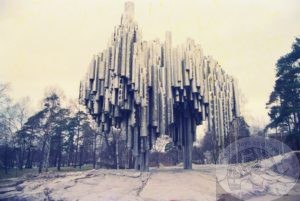
Jean Sibelius, Finland’s greatest composer – a work of art to commemorate the music and the composer.
Nokia, the Arctic, and Reindeer
In the early years, between the acting stints, I was still working on a television program that did travel segments, and as we had been in Turkey during the winter, so we went off to Finland in winter, because as every one knows, Santa lives at the north pole in Finland. It was the early 1990s, and we were all enthralled with pagers and the introduction of mobile telephones to the Thai market – none of us could afford them, the earliest phone that I can remember, with a huge battery, cost well over 3,000 dollars, and it was really only portable in the sense that it was the size of a briefcase. (Mind you, portable telephony had been envisioned as early as 1917, and the first real mobile phone was exhibited in 1973, weighing 2kg.) The difference between then and the last decade of the century was the fact that things went cellular). There was an interesting side-effect to the introduction of mobile telephone services in Thailand. For anyone who had been trying to have a landline or regular home telephone installed, the average waiting time was somewhere around 6 months. I was one of the people waiting for such an installation; but there was a faster way, if one was really desperate for a telephone at home. For a little ‘extra’ fee (of about 1,000 dollars) a telephone could be installed within a matter of days. Funnily enough, as mobile telephony spread across the city and the country like wildfire, hoards of erstwhile ‘forgotten’ and ‘lost’ home telephone numbers were located; within a year, more than 200,000 such numbers were unearthed, and I received a call that at the regular price of roughly 120 dollars, I could now have a line installed at home within a week – the offer was about a month too late as I was already toting the latest Nokia mobile.

25 years ago, this type of office space was visionary; today, more commonplace.
Mobile Technology
And it was to Nokia that we traveled in Finland on our quest to find some new and exciting technology. John Nuvo, a popular and well-known singer, was our MC for the trip, and in subsequent years John has continued to produce a television program introducing the latest technology to Thai audiences. We were whisked to Helsinki by Finnair, and we were met at the airport by a representative from Finnish Tourism Board. After an introduction to Finland, the country’s culture, and a blindingly cold walk along the waterfront, we settled in for the evening preparing first for a trip on the following day to Nokia. The 1980s and 1990s were the first decades of the technology boom, and computers and mobile telephony were all the rage. Coupled with these developments came the change in work environment, and a greater emphasis on work/life balance and the need for happier, healthier, more comfortable places of work. When we arrived at the head offices, it was not at some drab building along some non-descript street, but instead the building was modern, spacious, and well-lit. The décor included comfortable work spaces, comfortable seating areas complete with couches and cushions, and a coffee corner. It may sound strange to be writing about these things in the second decade of the 21st century where most office space is now well lit and comfortable and ‘google-ish’ in nature, but a quarter of a century ago we still knew what to do with a pencil and a cassette tape – things have changed.
Our tour of the facility included a presentation about new technologies being developed by the company, some of their human resources initiatives (including on-site child-care facilities), and of course a look at the latest truly mobile telephones soon to be launched. An additional presentation was made about a new wearable health monitor with a watch-like design. (it’s taken the world nearly 25 years to actually adopt these wearable devices, but now they are nearly as essential an item as mobile phones). We filmed our interviews and all the b-roll we needed; we had plenty of material to present the latest technological innovations in telephony to our audience.

John Nuvo dog sledding in the cold north, before the reindeer arrived.
The Arctic and Rovaniemi
It was time for us to move north, far north, and to learn about a little-visited region of the world, the arctic. There is a wonderful museum/science center which had just opened when we visited Finland, Arktikum, the University of Lapland’s Arctic Center and Regional Museum of Lapland, located in Rovaniemi. The exhibits deal, obviously, with life and history of the arctic circle region of Lapland, the people who inhabit this region; their art and culture. The center has several permanent exhibitions, but also presents new and interesting information as it becomes available. We were lucky to be able to visit this facility only shortly after it opened, and in the quarter of a century since, many thousands of people have learned how vitally important the region is to the world’s climate, and how climate change has affected the region and its people, the Sami. We were introduced to the economic importance of reindeer, the habits of polar bears, and the beauty of the Northern Lights. A ride in a sleigh pulled by reindeer prepared us for the next visit, and we learned how it is possible for that chubby old fellow to make the rounds of all those who have been naughty or nice in a single evening, all the while wishing every one a merry good night as his sleigh once again rushes off on the peals of a hearty ho-ho-ho. Saint Nick was our next stop, at the North Pole.
